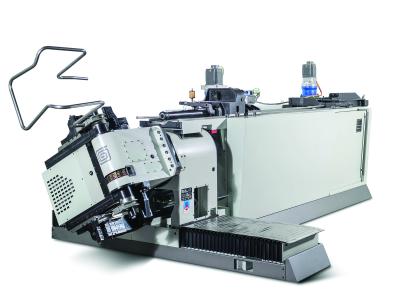
E-TURN, the all-electric tube bender from BLM GROUP USA, can bend a variety of tube configurations including round, square, rectangular, flat-sided, oval and elliptical. Tube can be automatically loaded, bent and unloaded all in one machine.
The series consists of four models: The E-TURN 32 that can handle tube up to 1.18 in. dia.; the E-TURN 35 that handles tube up to 1.38 in. dia.; the E-TURN 40 for tube up to 1.63 in. dia., and the E-TURN 52 for tube up to 2.0 in. dia. The standard maximum bending radius is 6.5 in. and can be increased if the need arises. The bend head incorporates a direct gear-box drive which eliminates backlash and delivers high accuracy and reliability.
The precise control and positioning of the all-electric axes provides for ideal working parameters that can be reproduced exactly—right the first time, every time. The precise control of its 15 axes movements ensures high positioning accuracy and repeatability, producing consistent quality bends.
Because of the E-TURN flexibility, accuracy and speed it is ideal for the furniture, pipe and automotive industries as well as for job shops. It is environmentally friendly with extremely low noise levels, no hydraulic oils, no leaks and no filter replacement.
Another key to the E-TURN Series’ enhanced performance is the easy-to-use VGP3D software with advanced 3D graphical programming. By simply inputting the component’s bend coordinates the software can quickly provide users with real-time simulation of the bending operation and automatically correct for possible collision points. VGP3D optimizes productivity while simultaneously enhancing quality and minimizing operator involvement. The software also permits off-line programming for high degrees of both automation and production planning.
Contact Details
Related Glossary Terms
- backlash
backlash
Reaction in dynamic motion systems where potential energy that was created while the object was in motion is released when the object stops. Release of this potential energy or inertia causes the device to quickly snap backward relative to the last direction of motion. Backlash can cause a system’s final resting position to be different from what was intended and from where the control system intended to stop the device.
